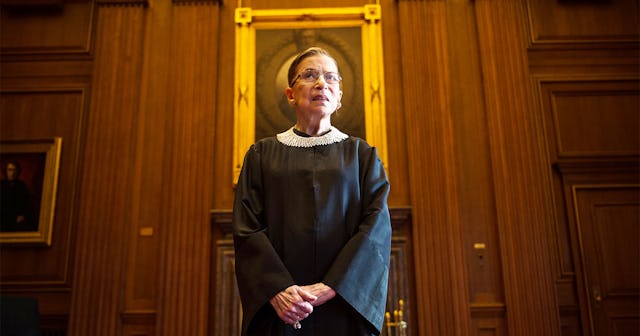How A Petite Jewish Woman Changed The World

There are moments in history that will forever stand out in our memories, moments for which we will be able to recall exactly where we were, when. Those moments range from world changing to life changing, on both a global level and sometimes simply on a personal level.
Justice Ruth Bader Ginsburg’s passing will be one of those moments for me. I will always remember where I was when I received the text from a friend telling me she’d died.
Her death is a tragedy. Because all death is a tragedy. Because she was a mother and grandmother and wife and so much to so many people. Because during her time in this world, she changed it for the better. And here’s a look at how:
The idea that a woman couldn’t get a mortgage without a man’s signature next to hers seems ludicrous in present day, but that was exactly the case when Ginsburg began practicing law. She paved the way for the enactment of the Equal Credit Opportunity Act in 1974, which allowed women to apply for mortgages and credit cards without a male co-signer. Thanks to Justice Ginsburg, women can do these things by themselves.
Her first case on behalf of the ACLU heard in front of the Supreme Court shot down a law that required men get preference over women as administrators of an estate. That case, Reed v. Reed, successfully established the use of the Equal Protection Clause of the 14th Amendment as an argument against gender discrimination, and would become the bedrock of future gender equality cases.
Chief Justice of the U.S. Supreme Court William Rehnquist (R) administers the oath of office to newly-appointed U.S. Supreme Court Justice Ruth Bader Ginsburg (L) as U.S. President Bill Clinton looks on 10 August 1993.
KORT DUCE/Getty
She didn’t only fight for women. In fact, in her time working as an attorney, she also fought for men’s equal rights. Prior to 1975, men did not receive survivor benefits under the Social Securities Act if their wives died, while women did if their husbands died. In Weinberger v. Wiesenfeld, Ginsburg successfully challenged the underlying belief that men did not need survivors’ benefits as they were the primary breadwinners in the household. Ginsburg’s work on this matter later set the stage for gay and lesbian couples, who had finally won the right to marry legally, to also receive benefits under the law.
When Justice Ginsburg fought for the widower in Weinberger v. Wiesenfeld she employed a strategy she’d used before. She took a position to fight for equal rights for a man, in order advance the importance of matters related to gender equality in the eyes of the law. She fought for a college-aged man’s right to buy (a light version of) beer at 18, which was a right women had been permitted under a local statute. That case ultimately changed the standard under which gender equality cases were reviewed by the court. By arguing for equality on behalf of male plaintiffs, Justice Ginsburg chipped away eroded long held gender beliefs.
Nikki Kahn/The Washington Post/Getty
In a separate case that she hoped would expand reproductive rights for all women, she argued on behalf of a combat nurse who was forced to choose between terminating her pregnancy or losing her career. Justice Ginsburg had hoped to establish women’s right to control their fertility via a case that argued for the right to give birth.
It’s a strategy that sounds almost like reverse psychology, but in an article for Time, Stephanie Buck described it more artfully as a “patient strategy”. And it worked.
Justice Ginsburg also made it possible for women to:
- Open a checking account without a male co-signer
- Receive equal consideration in the determination of who may act as executors of their children’s estates
- Start a business and secure a business loan without a male co-signer
- Obtain a job without gender based discrimination and then retain that same employment while pregnant
- Acquire birth control without first obtaining her husband’s permission
- Secure employment and retain that employment without being forced to provide proof of sterilization
- Receive pension benefits that are equal to male coworkers
At 5’1”, Ruth Bader Ginsburg did not stand particularly tall. But the bright light of all she has done to make our world a better place will always shine large.
In Jewish tradition, when someone dies, the words of comfort are not “rest in peace,” but “may her memory be for a blessing” or “may her memory be a blessing.” I am by no means a Jewish scholar, and to be honest, only first paid attention to what people said after a death when my own young husband died, but I’ve since made an effort to understand the phrase. And from my understanding, it’s particularly suited for Justice Ruth Bader Ginsburg.
Judaism doesn’t offer a definitive answer as to what happens after someone dies. There are a few core theories, but no single answer. Instead, the focus, as I understand it, is on what Rachel Stomel called in a piece for Kveller.com “active remembrance.”
Which means remembering by speaking the deceased person’s name and carrying on their legacy.
More recently, activists have begun to use the phrase “may her memory be a revolution.” The phrase first came about in response to domestic violence deaths, and then was also used by activists in the wake of George Floyd’s death. The call was meant to memorialize the lives lost through active remembrance, through direct action, through revolutionary changes.
Justice Ginsburg changed the world, and now we have the honor of carrying on her legacy and ensuring her memory is both a blessing and a revolution.
This article was originally published on